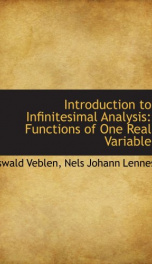Lennes Nels Johann

Oswald Veblen (24 June 1880 – 10 August 1960) was an American mathematician, geometer and topologist, whose work found application in atomic physics and the theory of relativity. He proved the Jordan curve theorem in 1905. Veblen was born in Decorah, Iowa. He went to school in Iowa City. He did his undergraduate studies at the University of Iowa, where he received an A.B. in 1898, and Harvard University, where he was awarded a second B.A. in 1900. For his graduate studies, he went to study mathematics at the University of Chicago, where he obtained a Ph.D. in 1903. His dissertation, A System of Axioms for Geometry was written under the supervision of E. H. Moore. Veblen taught mathematics at Princeton University from 1905 to 1932. In 1926, he was named Henry B. Fine Professor of Mathematics. In 1932, he helped organize the Institute for Advanced Study in Princeton, resigning his professorship to become the first professor at the Institute that same year. He kept his professorship at the Institute until he was made emeritus in 1950. Veblen died in Brooklin, Maine, in 1960 at age 80. After his death the American Mathematical Society created an award in his name, called the Oswald Veblen Prize in Geometry. It is awarded every three years, and is the most prestigious award in recognition of outstanding research in geometry. During his career, Veblen made important contributions in topology and in projective and differential geometries, including results important in modern physics. He introduced the Veblen functions of ordinals and used an extension of them to define the small and large Veblen ordinals. He was involved in overseeing the World War II work that produced the pioneering ENIAC electronic digital computer. He also published a paper in 1912 on the four-color conjecture. Veblen's uncle was Thorstein Veblen, noted economist and sociologist.
do you like this author?
What readers are saying
What do you think? Write your own comment on this book!
write a commentWhat readers are saying
What do you think? Write your own comment on this author!
write a commentBook list

Introduction to Infinitesimal Analysis
Functions of one real variable
Series:
Unknown
Year:
Unknown
Raiting:
4/5
Show more
add to favoritesadd In favorites

Solid Geometry with Problems and Applications (Revised edition)
Series:
Unknown
Year:
Unknown
Raiting:
2.5/5
Show more
add to favoritesadd In favorites
Book list

Introduction to Infinitesimal Analysis
Functions of one real variable
Series:
Unknown
Year:
Unknown
Raiting:
4/5
Show more
add to favoritesadd In favorites

Solid Geometry with Problems and Applications (Revised edition)
Series:
Unknown
Year:
Unknown
Raiting:
2.5/5
Show more
add to favoritesadd In favorites
What readers are saying
What do you think? Write your own comment on this author!
write a commentif you like Lennes Nels Johann try:
readers also enjoyed
What readers are saying
What do you think? Write your own comment on this author!
write a commentGenre
if you like Lennes Nels Johann try:
readers also enjoyed
Do you want to read a book that interests you? It’s EASY!
Create an account and send a request for reading to other users on the Webpage of the book!


